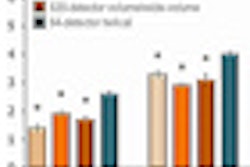VANCOUVER - When used optimally, CT is one of medical imaging's most valuable tools. But for patient safety, the challenge is to dial down radiation dose while also increasing image quality, according to a presentation on Sunday at the annual American Roentgen Ray Society (ARRS) meeting.
CT is getting particular attention in the current healthcare reform environment because as its use has continued to grow -- CT now represents 17% of all imaging exams -- it has become the biggest source of radiation dose to patients, according to Dr. Marilyn Siegel of the Mallinckrodt Institute of Radiology at Washington University Medical Center.
"In 1980, the per capita radiation dose from CT was 3.6 mSv," Siegel told session attendees. "In 2007, which is the most recent data, that dose was 6.2 mSv, almost double -- and it's going up. That's why there's heightened interest in managing CT dose."
Siegel distinguished between deterministic radiation exposure risk -- that is, those radiation effects related to planned therapies -- and stochastic effects caused by unplanned radiation exposure, which can take decades to manifest. Deterministic risk is generally not an issue in medical imaging unless a patient receives a dramatic overdose of radiation, such as in the 2009 case at Cedars-Sinai Medical Center, in which patients were overexposed to radiation during CT brain perfusion scans, Siegel said.
If an individual's lifetime cancer risk is between 20% and 25%, what, if any, risk is added from exposure to radiation at the level of the average CT scan (10 mSv)? A middle-aged adult who undergoes an average CT has an increase in lifetime risk of cancer of 0.05%, Siegel said. Younger patients are at higher risk not only because they have more years to live, but because they are also more radiosensitive.
As for the actual number of cancers related to CT, Siegel cited a 2007 study published in the New England Journal of Medicine that found that approximately 0.4% of all cancers in the U.S. could be attributed to radiation from CT studies, based on risk estimates and data on CT use from 1991 to 1996. Adjusting to 2007 CT use, the study authors estimated that the figure would be in the range of 1.5% to 2% (NEJM, November 2007, Vol. 357:22, pp. 2277-2284).
"[The cancer risk from CT] is almost certainly higher now," Siegel said.
Cancer risk from CT is doubled for 20-year-old patients, while the risk is 50% lower for 60-year-old patients, according to Siegel. Coronary angiography and thoracic CT exams had the highest associated lifetime risk of cancer, she said, referring to a study published in 2009 in the Archives of Internal Medicine (December 2009, Vol. 169:22, pp. 2078-2086).
Two pillars of dose reduction
There are two basic pillars to CT dose reduction, Siegel told session attendees: appropriate use and optimized CT protocols. Providers need to justify the study or use other modalities such as ultrasound or MRI when they offer comparable or more information. And avoiding repetitive studies is crucial -- although repeat studies are more likely to happen in the emergency department.
"One five-year emergency department study found that the average radiation dose per patient was 45 mSv, and 12% of patients received 100 mSv or more," Siegel said.
CT technique can be adjusted to ensure that dose is as low as reasonably achievable:
- Optimize mAs and kVp settings by weight-based protocols or automated software
- Adjust pitch
- Reduce the number of contrast-enhanced scans
- Limit scan range
Other tools for CT dose reduction include hardware improvements from vendors such as dual-energy scanning and iterative reconstruction software, Siegel said.
"Once you've had a CT scan, you've had it; the effect doesn't diminish," Siegel said. "It's not like smoking, where once you stop, you can get your risk of disease back down to zero."



















